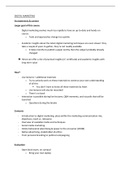DIGITAL MARKETING
Arrangements & context
Larger goal of this course
- Digital marketing evolves much too rapidly to have an up-to-date and hands-on
course:
o Tools and approaches change too quickly
- Academic insights about the latest digital marketing techniques are even slower: they
take a couple of years to gather, they’re not readily available
o It takes months to publish a paper and by then the subject probably already
changed
➔ Hence we offer a mix of practical insights (cf. certificate) and academic insights with
long-term value
How?
- Live lectures + additional materials
o Try to actively work on these materials to construe your own understanding
of all this
▪ You don’t have to know all these materials by heart
o Live lectures will also be recorded!
o There’s no book
- Interaction is possible during live lectures, Q&A moments, and via polls that will be
launched
o Questions during the breaks
Contents
- Introduction to digital marketing: place within the marketing communication mix,
objectives, reach vs. relevance
- Overview of available media and techniques
- Social media marketing
- Online behavioral advertising & power to the consumer (WOM)
- Native advertising, stakeholders & ethics
- From personal branding to political campaigning
Evaluation
- Open book exam, on campus!
o Bring your own laptop
, o He doesn’t care about the syntax of questions, you can use arrows etc.
o Certificate!
- Different questions
o Multiple choice
o Short answers
o Short essays
- The exam assesses knowledge, but also understanding and application of the insights
and perspectives offered in the course
Context: ‘digital’ & ‘marketing’
- We will focus on the communication part and the human psychological part of digital
marketing, more than marketing people do (who solely look at it in a system kind of
way)
- Online/digital
o = everything that is online
o Everything digital could be part of this course, but we focus on the larger
media and platforms, where the aggregate effect on individuals and society is
substantial. At the same time, we take a systems approach, trying to
understand evolution dynamics in digital media marketing, such that you’ll be
able to also understand the rise of new techniques, platforms or even media
- Marketing
o = with marketing, we imply marketing communication and not marketing as a
whole
o There’s a focus on marketing communication because this best fits the
communication sciences expertise and because this is what consumers and
most marketers deal with
What is ‘digital marketing’ according to you? (pollev)
- Social media
- Online
- Marketing
- Brands
- Strategy
- Analytics
- …
➔ The above key words come from the perspective of digital marketeers
, ➔ E.g. if you would ask the European commission what digital marketing is, they would
say: a privacy problem! (different perspective)
o There’s happened a lot in the regulation of digital marketing
What do you think about ad blockers? (pollev)
- The majority never uses ad blockers, followed by people who use ad blockers on
some devices and apps
- Five years ago a lot of students were using ad blockers!
➔ Maybe because nowadays we think ads are more interesting and relevant
o + some websites and services are adapted to ad blockers → you can’t enter
these platforms if you use ad blockers (e.g. news sites)
▪ That’s why more and more people use ad blockers for some sites and
not for other sites
Which browsers do you typically use?
- Safari and Mozilla Firefox use adblockers by default!
o They block some ads automatically
Marketing Communication Mini Course
Marketing communication media and tools
- When you talk about marketing communication in general (not only digital
marketing), you need to talk about media
o Because marketing communication always needs a carrier, a medium to
transfer the communications
, o Historically, media were divided in above- and below-the-line media (=old
division)
▪ Above-the-line media:
• Mass media (TV, internet, radio, newspapers), specialized
media ads (magazines, movie theatres,…) and outdoor
advertising (billboards, train stations,…)
o Historically, these media were most interesting for
advertising agencies, because they made more money
with it (15% of the money that was spent on mass
media campaigns went to the agency that created the
ad)
▪ Still nowadays, +/- 80% of the marketing budget
goes to the placement of the ad and 20% to the
creation of the ad
▪ Below-the-line media
• Sponsorships, POP marketing, direct marketing, sales, trade
fairs, brand websites, word-of-mouth,…
o Historically, below-the-line media campaigns ended up
with niche advertising agencies, because the big
agencies preferred to work with above-the-line media
▪ Nowadays, you still see that big advertising
agencies say that they offer 360 degrees
marketing (thus above- and below-the-line), but
they still prefer to do mass media campaigns
(above-the-line)
o Thus, for the last decades the advertising industry was
geared towards mass media, non-personalized, only a
bit targeted campaigns (and this was targeting in terms
of media and content rather than in terms of
customers)
▪ → nowadays targeting happens based on
people/target audiences rather than content
o Nowadays, media are mostly divided into:
▪ Paid media
• You pay a medium to host your ads
• All of the above-the-line media fall under paid media
▪ Owned media
• Media that you host yourself (you mostly invest time in it)
o But, this also costs a bit of money: e.g. you have to pay
to own your own website or to use certain services
▪ Earned media
• Everything that happens without you having control over it




